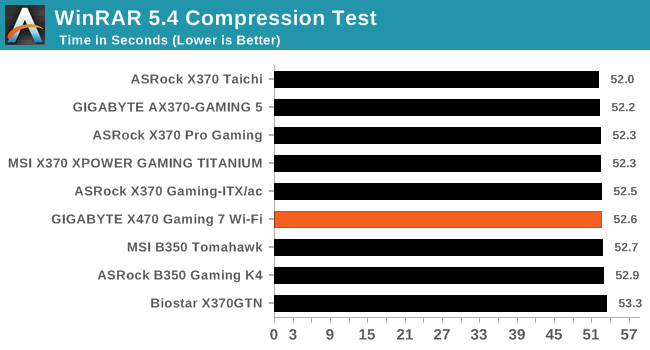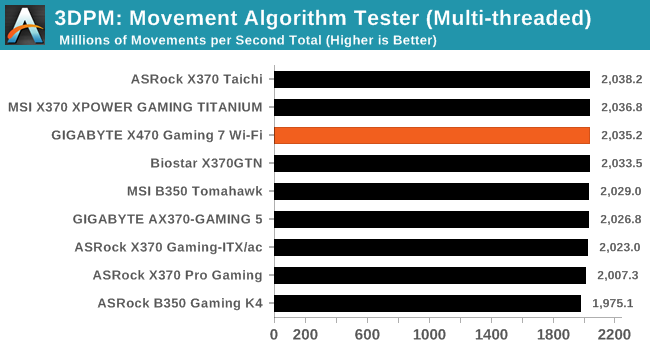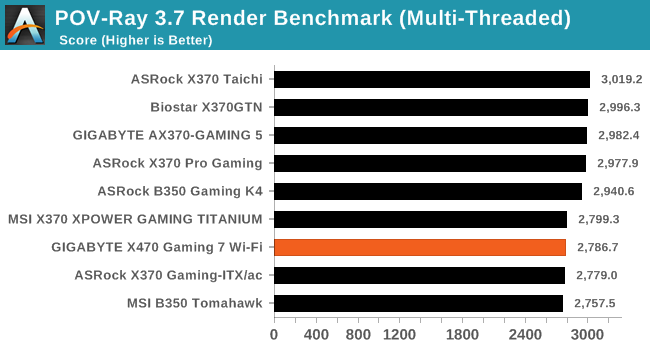The GIGABYTE X470 Gaming 7 Wi-Fi Motherboard Review: The AM4 Aorus Flagship
by Gavin Bonshor on July 26, 2018 8:00 AM EST- Posted in
- Motherboards
- AMD
- Gigabyte
- AORUS
- Ryzen
- X470
- Ryzen 2
- Gaming 7 Wi-Fi
- Gaming 7
CPU Performance, Short Form
For our motherboard reviews, we use our short form testing method. These tests usually focus on if a motherboard is using MultiCore Turbo (the feature used to have maximum turbo on at all times, giving a frequency advantage), or if there are slight gains to be had from tweaking the firmware. We put the memory settings at the CPU manufacturers suggested frequency, making it very easy to see which motherboards have MCT enabled by default.
Video Conversion – Handbrake v1.0.2: link
Handbrake is a media conversion tool that was initially designed to help DVD ISOs and Video CDs into more common video formats. For HandBrake, we take two videos and convert them to x264 format in an MP4 container: a 2h20 640x266 DVD rip and a 10min double UHD 3840x4320 animation short. We also take the third video and transcode it to HEVC. Results are given in terms of the frames per second processed, and HandBrake uses as many threads as possible.



Compression – WinRAR 5.4: link
Our WinRAR test from 2013 is updated to the latest version of WinRAR at the start of 2017. We compress a set of 2867 files across 320 folders totaling 1.52 GB in size – 95% of these files are small typical website files, and the rest (90% of the size) are small 30 second 720p videos.

Point Calculations – 3D Movement Algorithm Test v2.1: link
3DPM is a self-penned benchmark, taking basic 3D movement algorithms used in Brownian Motion simulations and testing them for speed. High floating point performance, MHz and IPC wins in the single thread version, whereas the multithread version has to handle the threads and loves more cores. For a brief explanation of the platform agnostic coding behind this benchmark, see my forum post here. We are using the latest version of 3DPM, which has a significant number of tweaks over the original version to avoid issues with cache management and speeding up some of the algorithms.

Rendering – POV-Ray 3.7.1b4: link
The Persistence of Vision Ray Tracer, or POV-Ray, is a freeware package for as the name suggests, ray tracing. It is a pure renderer, rather than modeling software, but the latest beta version contains a handy benchmark for stressing all processing threads on a platform. We have been using this test in motherboard reviews to test memory stability at various CPU speeds to good effect – if it passes the test, the IMC in the CPU is stable for a given CPU speed. As a CPU test, it runs for approximately 2-3 minutes on high-end platforms.

Synthetic – 7-Zip 9.2: link
As an open source compression tool, 7-Zip is a popular tool for making sets of files easier to handle and transfer. The software offers up its own benchmark, to which we report the result.











29 Comments
View All Comments
DigitalFreak - Thursday, July 26, 2018 - link
The M.2 slot furthest from the CPU is PCI-E 2.0 x4, not PCI-E 3.0.gavbon - Thursday, July 26, 2018 - link
Good spot, edited and thank you :)DigitalFreak - Thursday, July 26, 2018 - link
One other thing - the 3rd (x4) PCI-E slot is PCI-E 2.0, not 3.0.Hxx - Thursday, July 26, 2018 - link
Gigabyte's BIOS is like the quest to create as many submenus as possible and to bury things as deep as they can be buried within those menus. Luckily my Aorus z370 gaming 7 gets the job doneSpoelie - Thursday, July 26, 2018 - link
Another ATX board :/Wanted to upgrade to Ryzen 2 on an ITX board with a 4xx chipset for "proper" precision boost support - but am still waiting on availability of the damn things.
It's come to a point where I'm contemplating skipping this generation as well and wait for 7nm/Ryzen 3 in H1 next year - a "new" desktop nowadays is 5+ year investment anyway
tarqsharq - Thursday, July 26, 2018 - link
I've had my Asus X470 ITX board since the end of May or so?But yeah, waiting for the 7nm shrink might be a really good idea.
29a - Thursday, July 26, 2018 - link
I'm in the same boat as you Spoelie, I'm wanting to upgrade but I want a board with proper precision boast on a lower end chipset in a uATX or ITX form factor but AMD has been so slow about coming out with the new chipsets that now I'm to the point that I should probably wait for Zen2 and the new GPUs.DanNeely - Thursday, July 26, 2018 - link
I'm not sure which is stupider, the frag harder lights on 2 of the PCIe x16 slots, or that they cheaped out and left the 3rd normal.29a - Thursday, July 26, 2018 - link
Just don't turn them on and what seems to be a major source of stress in your life will go away.29a - Thursday, July 26, 2018 - link
Is it me or is this article hard to read? Here are some examples of strange sentences."While not a budget board in any sense of the phrase ($240), the selection of controllers highly the potential upturn in cost for the X470 Gaming 7. "
"While the X370 predecessor to this board (GIGABYTE AX370 Gaming K7) did feature a single U.2 port, GIGABYTE has omitted to implement one onto the X470 Gaming 7. Instead, two M.2 slots are present with both offering support for NVMe PCIe x4 and SATA SSDs with both slots featuring their own individual stylish and functional M.2 heat sinks."